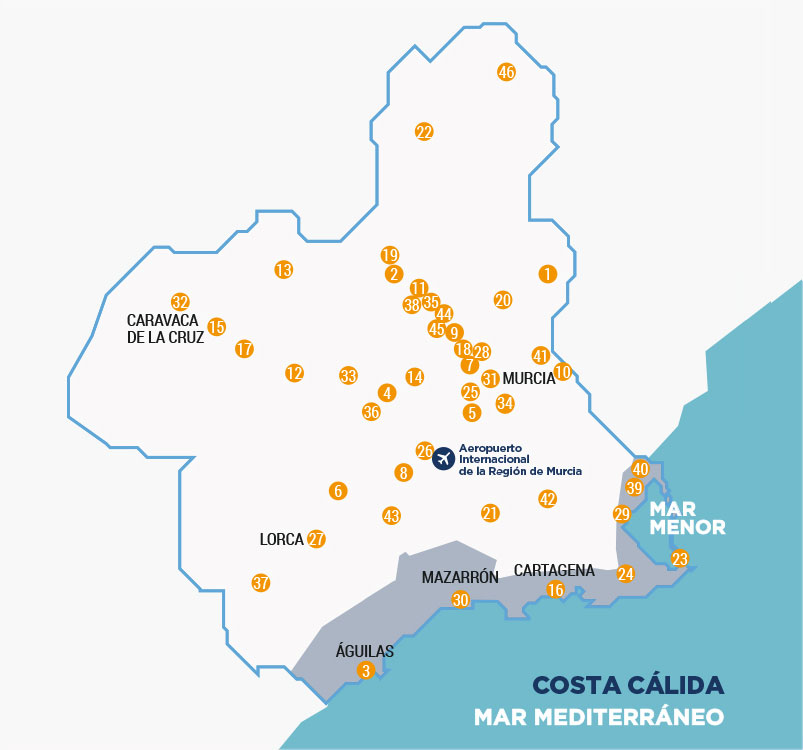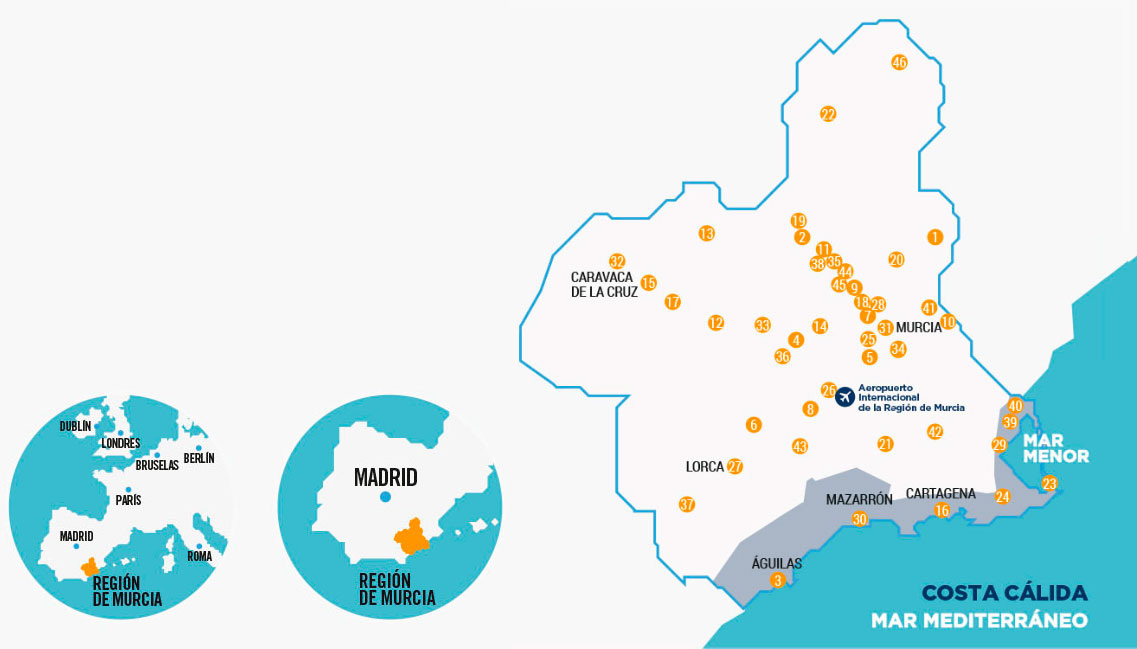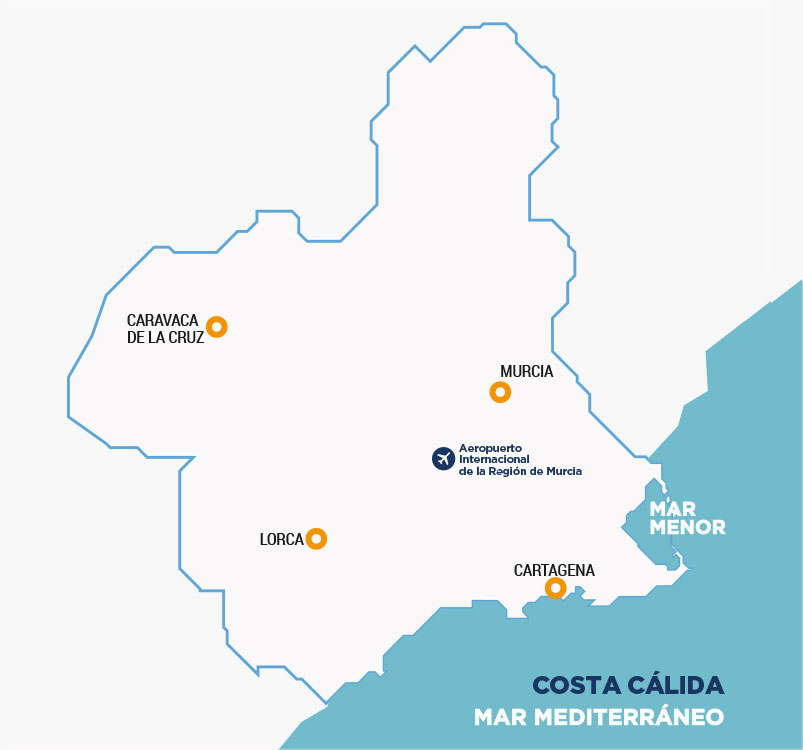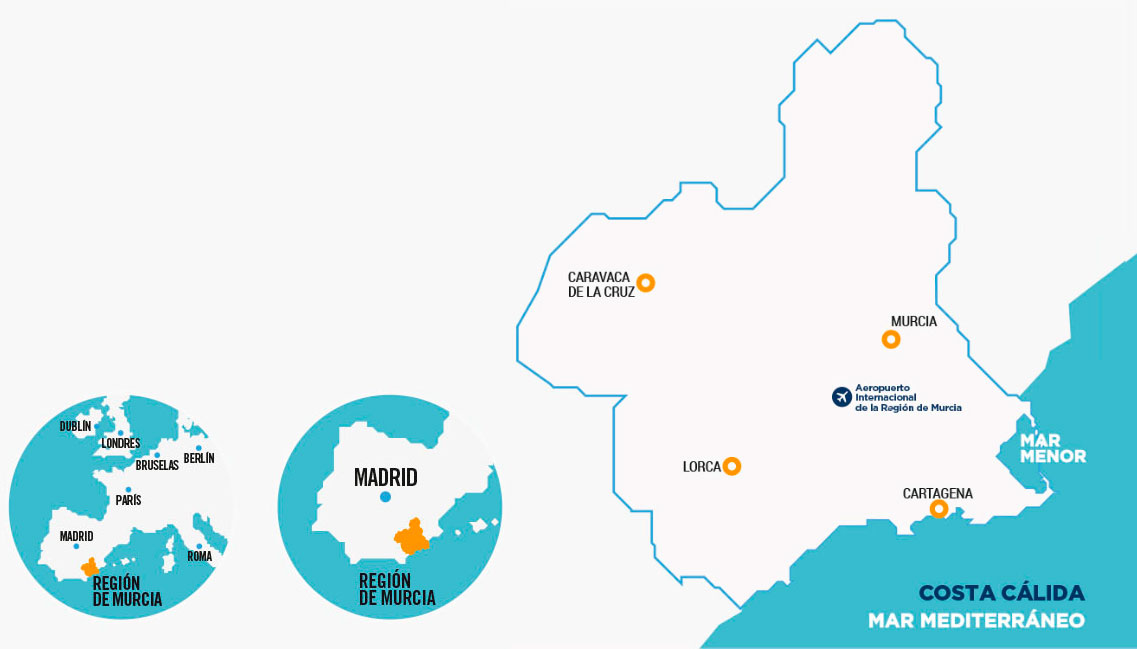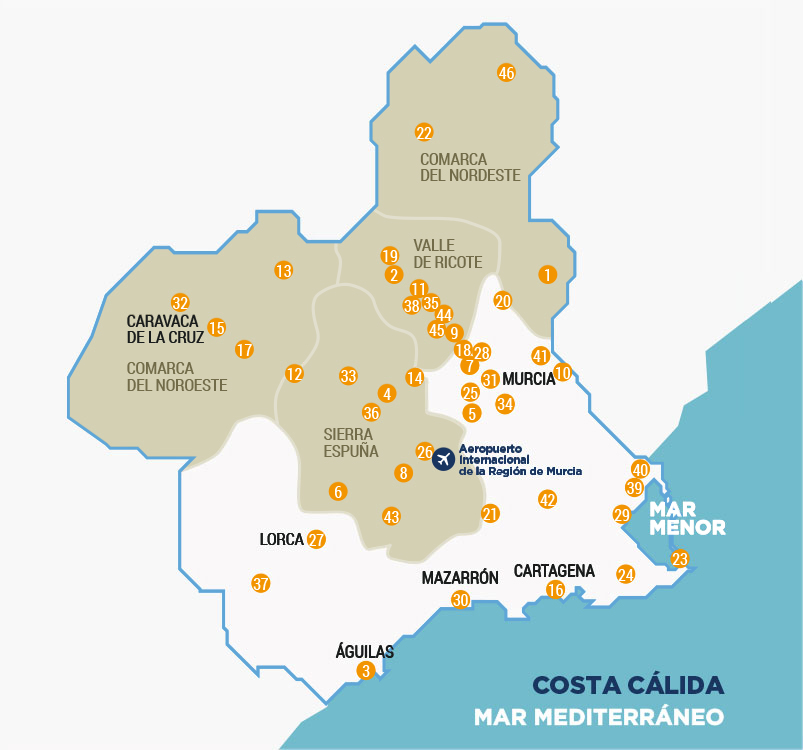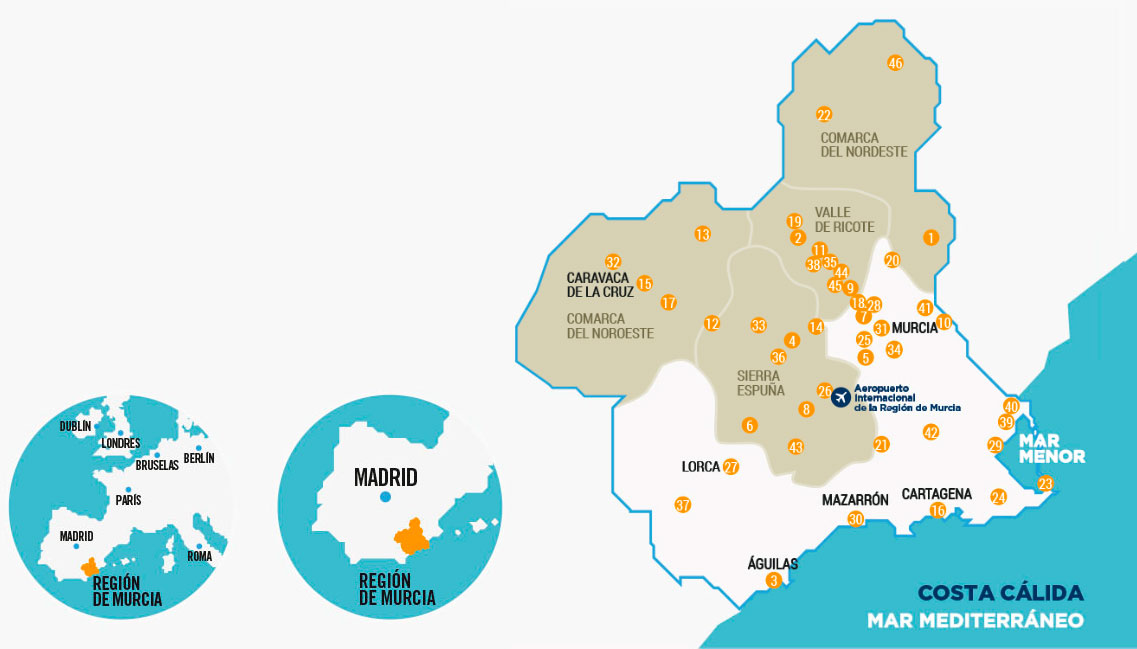Localities

- 1 ABANILLA
- 2 ABARÁN
- 3 ÁGUILAS
- 4 ALBUDEITE
- 5 ALCANTARILLA
- 6 ALEDO
- 7 ALGUAZAS
- 8 ALHAMA DE MURCIA
- 9 ARCHENA
- 10 BENIEL
- 11 BLANCA
- 12 BULLAS
- 13 CALASPARRA
- 14 CAMPOS DEL RIO
- 15 CARAVACA DE LA CRUZ
- 16 CARTAGENA
- 17 CEHEGÍN
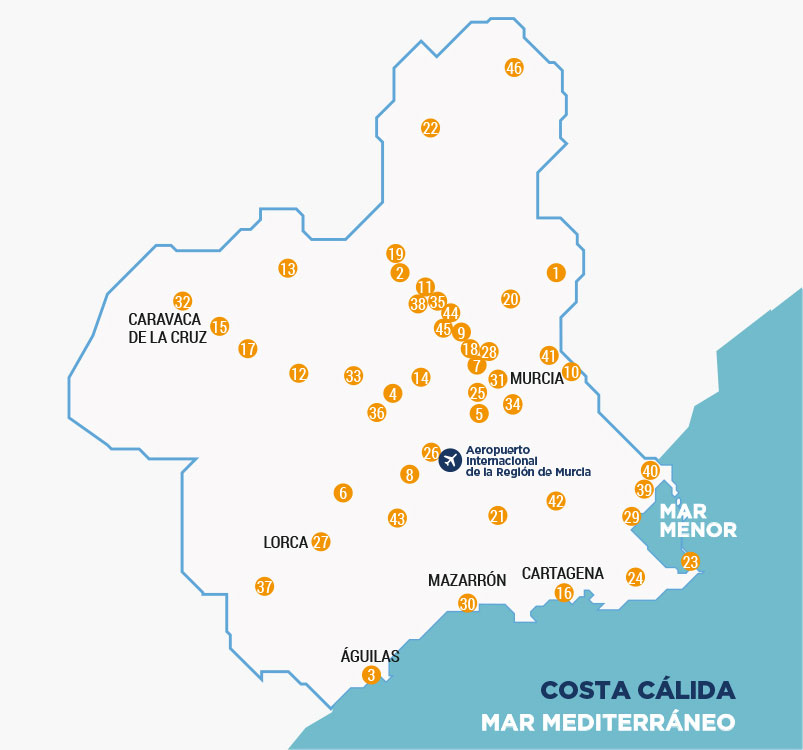
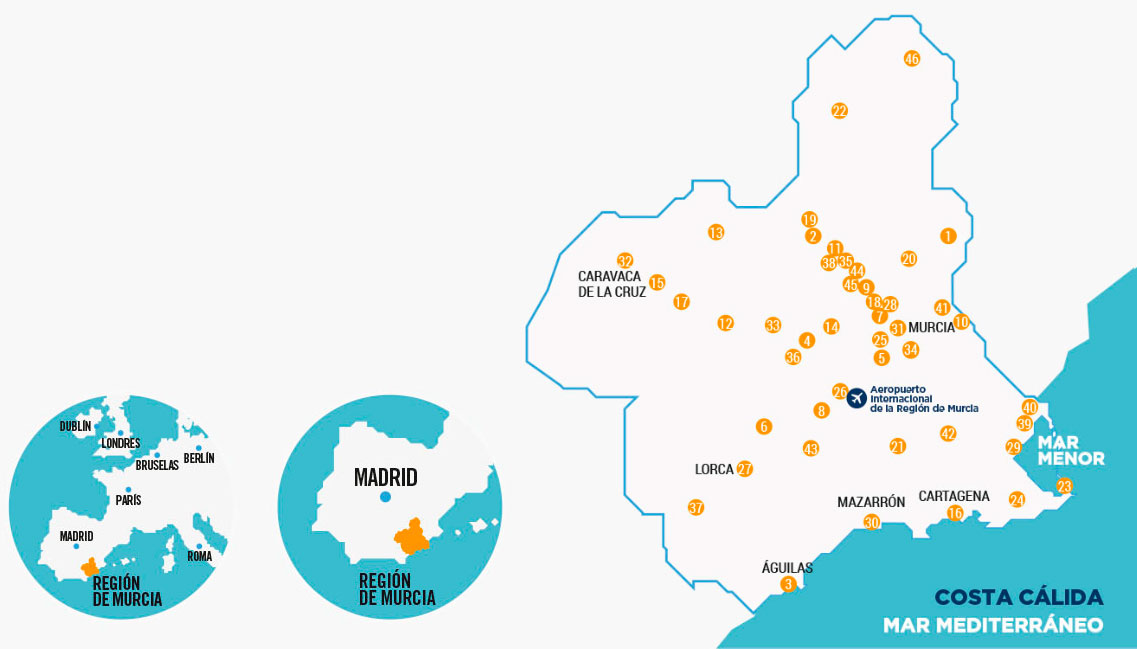
- 1 ABANILLA
- 2 ABARÁN
- 3 ÁGUILAS
- 4 ALBUDEITE
- 5 ALCANTARILLA
- 6 ALEDO
- 7 ALGUAZAS
- 8 ALHAMA DE MURCIA
- 9 ARCHENA
- 10 BENIEL
- 11 BLANCA
- 12 BULLAS
- 13 CALASPARRA
- 14 CAMPOS DEL RIO
- 15 CARAVACA DE LA CRUZ
- 16 CARTAGENA
- 17 CEHEGÍN
- 18 CEUTI
- 19 CIEZA
- 20 FORTUNA
- 21 FUENTE ÁLAMO
- 22 JUMILLA
- 23 LA MANGA
- 24 LA UNIÓN
Top 10
It is said that the Northeast is like a Castilian knight: elegant and filled with nobility. This area of countless possibilities has broad plains, vineyards and magnificent mountain ranges; it is proud of its history, culture and festivities.
WINE ROUTES
The Northeast serves as an excuse to come to the interior of the region and enjoy great wines and experiences. To be more precise, the wines from Jumilla and Yecla -both with a Guarantee of Origin- are the leitmotif in our routes including visits to wineries, museums and wine cellars, wine tastings, walks through some vineyards, workshops, concerts, and numberless activities to make your stay an unforgettable episode. A trip reserved for gourmets.
FOR EPICUREANS
The Northeast offers delicious rice dishes and gazpachos, grilled meat and cold cuts, good wines such as those from Jumilla and Yecla, and typical pastries such as aniseed ring-shaped pastries, pirusas and sequillos. It is one of those places where the gastronomic wisdom has been marked by centuries of history and traditions. The wisest thing to do is not wander anymore, sit down and taste our delicacies.
THERMAL WATERS
In Fortuna is the balneario -thermal spring spa- of Leana, which is among the oldest of its kind in Spain. Rebuilt on Roman baths, it constituted the area's biggest healing centre at its time, together with the Cueva Negra -Black Cave- sanctuary, famous for its Tituli Picti. Previous peoples, such as the Iberians and Greeks, also knew about the healing properties of these waters. If everybody continues to come here in order to recharge batteries, it must be for a reason.
JUMILLA CASTLE
This castle, commissioned by the Marqués de Villena in 1461 and built on a Muslim fortification, is nowadays a restoration example and a busy cultural centre. In order to get to it, you should go through the Camino del Subidor, a natural viewpoint from which you will enjoy one of the most amazing panoramic views in the region. It has been declared a National Monument.
MAGIC MOUNTAINS
One of Yecla's most appreciated natural settings is Monte Arabí. Known as the magic mountain, this spectacularly beautiful place is supplemented by many legends and myths. It is really worth going on a trip in order to admire these wonderful landscapes. The walls of the Cantos de la Visera and the Cuevas del Mediodía still conserve some Neolithic cave paintings. Moreover, among Yecla, Jumilla and Fortuna are the regional parks of Sierra del Carche and Sierra de la Pila, where you can enjoy astonishing geological formations, nature routes, hang gliding, paragliding...
IS IT AN ORIGINAL OR A COPY?
El Greco Replica Museum in Yecla has a collection of 73 oil paintings; all of them are shown on the second floor of the locality's Municipal House of Culture in the Ortega House-Palace. If you come and see works such as 'The Apostolate', 'The Despoilment' and 'The Nobleman with his Hand on his Chest', you will probably doubt whether they are replicas or not.
DRESS COATS AND TWO-CORNERED HATS
A great uproar of drums and harquebus announces the arrival of hundreds of tiraores -shooters- wearing dress coats and two-cornered hats. These are the Patron Saint's Day Celebrations in Yecla, declared to be of National Tourist Interest. These celebrations -which are more than 350 years old- take place in December every year, honouring the Virgen del Castillo and thanking Her for the safe and sound return of the people from Yecla who fought in the War of the Spanish Succession.
THE CROSS AND THE CRESCENT
If you are lucky enough to come to Abanilla towards the end of April and the beginning of May, you can participate in the Festivities Honouring the Holy Cross and of Moors and Christians, which are among the most traditional ones in the whole region. It is worth watching the colourful parades while listening to the pasodoble, witnessing the salute of the harquebusiers, or going in a procession with the Holy Cross to Mahoya Hermitage among the cheers, emotions and promises of the crowd. These festivities have been declared to be of Regional Tourist Interest.
A STRANGE SYMBIOSIS
In mid-August, Fortuna is invaded by legions of Iberians and Romans, nymphs, ballerinas, fire eaters and mythical characters. The Iberian-Roman Sodales Festivities, which are celebrated to honour San Roque and where some historical passages are recreated, have their high points at the Kalends of August, the Pursuit of the Lucerne and the magnificent parade of August 15th, declared to be of
PAGAN AND SACRED RED WINE
Coinciding with the Grape Harvest, the Ntra. Sra. de la Asunción Festivities are celebrated in mid-August in Jumilla: thousands of wine litres and typical products are distributed among the people. According to tradition, everybody wears a white shirt which will be dyed purple as the day goes on. Very important too is the locality's Holy Week, declared to be of National Tourist Interest. It stands out for the solemnity of its processions of a Franciscan origin, its proclamations and its procession starting at Santa Ana Monastery.
Top 10
This area has an overstory which is thought to be the biggest in the region and one of its most emblematic natural settings: Sierra Espuña Regional Park. Scene of fights between Moors and Christians, pottery area par excellence, active tourism sanctuary¿ Sierra Espuña is one of the greenest and thickest areas in the southeast of Spain and a real temptation for nature enthusiasts.
GREEN PATHS
Are you looking for fresh air, a scent of resin in the morning, walks in the middle of nature? Come to Sierra Espuña Regional Park and enjoy any of the routes through this legendary setting: hiking and orienteering activities are very popular here. And if you come across an arrui -barbary sheep- or a wild boar, you should remember that they have right of way over you.
PARAGLIDING
Alhama is one of the best places to fly. The take-off runway is a slope of the mountain, and the landing runway is the surrounding multicoloured field. There are tandem flights available, so you don't need experience; all you need is enthusiasm. Flying without any engine noise, with the art of thermaling, and enjoying the air around you will leave you speechless. If you experience it in the afternoon, you will never forget this special sunset.
SNOW WELLS
Some of the most popular curiosities in Sierra Espuña Regional Park are its snow wells. These constructions have been used from the 16thC to the 20thC in order to keep snow and supply ice to people in Alhama and the surrounding areas. Now in disuse, they act as witnesses for a way of life from the past. There are 25 of them among the summits of the Regional Park but... You have to climb up 1,400m to enjoy them. Quite an experience.
CLIMBING
Rock climbing shoes are frequent in Sierra Espuña. At the Leyva Ravine, a spectacular limestone wall -almost 200m high- is waiting for you. It has more than one hundred climbing tracks; climbers of all levels come here since this place is considered to be an important climbing school, due to the variety of the tracks, the quality of the stone and the beautiful scenery. This will definitely give you a rush of adrenaline.
POTTERY
If you enjoy being at one of the most active handicraft and pottery centres in the Iberian Peninsula, you are at the right place. Don't miss the opportunity to witness an exhibition at the various workshops of the Ollerías Quarter in Totana, where some of Spain's most important pottery craftsmanships used to be in the past.
ARCHAEOLOGICAL ROUTES
In La Bastida de Totana site, the continental Europe's most powerful city during the Bronze Age -4,200 years ago- is waiting for you, as well as is a fortified square, comparable to Troy's second city. Of special interest are the dwellings, graves and ceramic objects found. A classical touch characterises Los Villaricos old Roman villa in Mula. The site is divided into a residential area -with thermal zones and domestic spaces -and a working area -with remains of wine and oil mills-.
CULTURE AND ART
Mula has one of the most important museums of Iberian culture in the world: El Cigarralejo. It has a collection of 80 grave goods from a nearby Iberian necropolis, as well as other ceramic pieces, stone sculptures and weapons. Another emblem of this locality is the Casa Pintada -Painted House-: a house-palace of 1770, now the Contemporary Art Interpretation Centre. It is one of the four venues in the world, together with the ones in New York, Valladolid and Barcelona, exhibiting sculptures and paintings by Cristóbal Gabarrón, the famous artist from Mula.
LA SANTA
Santa Eulalia Monastery in Totana, known by locals as La Santa, is one of the municipality's treasures. The shrine's Baroque altarpiece, the Mudejar coffered ceiling and the 17thC paintings make this church a great treasure within the Region of Murcia's artistic heritage. It is 7km away from the town and surrounded by big pine forests, vegetable gardens and orchards; once you are here, you will definitely understand the true nature of this special place. We recommend you go to the Virgen Blanca Viewpoint, from which you will admire one of the most wonderful views in the area.
LOCAL FESTIVITIES
At midnight on Holy Tuesday every year starts a drum roll in Mula which is prolonged until 4 pm the following day. This is the Night of the Drums: everybody can take part in the celebration, as long as they bring a drum and wear a black tunic. Other festivities in the area which have been declared of Tourist Interest are the Holy Week in Totana and Los Mayos in Alhama de Murcia.
REALLY UNIQUE SPOTS
The more you explore, the more unique spots you find in Sierra Espuña, such as the Torre del Homenaje in Aledo, the Castle and Calle del Agua street in Pliego, the Castle in Alhama de Murcia, El Berro small village... Indulge yourself and visit these charming places where time has not passed; take the opportunity to taste this area's excellent cuisine.
Top 10
The Northwest bears the hallmark of contrast. This area has mountain moors, vineyards, cornfields, ricefields and mountain ranges. The origin of its history dates back to the Paleolithic period, and its geography makes places be unique enclaves, very different from the rest of the region and far from traditional crossing points.
UNDERGROUND WORLD
We do not have proof that Jules Verne ever was in the Region of Murcia, but we are sure he would have appreciated the fact that Calasparra has something similar to the entrance to the Centre of the Earth. The Cueva del Puerto, with a distance of 14km, is a reference cave if you enjoy spelunking, stalactites and stalagmites. Adventure, sports and science, all in one.
TABLE AND TABLECLOTH
Visiting this area is a piece of cake. In addition, it has one of Spain's best rice types: Calasparra rice, with guarantee of origin. It combines perfectly with wines from Bullas, also with guarantee of origin, and famous for their taste and intensity. Moreover, adding a wide range of stews, such as empedrao and rin ran, and some typical pastries, such as yemas from Caravaca de la Cruz, you get a quite tasty route.
THE LOST CITY
Just 3km away from Cehegín is Begastri, a Roman-Visigothic city, considered to be Spain's most important villa of its kind. Iberians, Romans and Visigoths settled in this place, which has been hidden for centuries, and the symbol of which is the 'Monogrammatic Cross'. Experience archaeology in its purest form.
AT THE TOP
One of the excuses to visit the Northwest is going up the region's highest peak on the Macizo de Revolcadores in Moratalla, which seems to have been created for mountain climbers. The difficulty is moderate and the views from the top are outstanding. At about ground level is the Sabinar -savin forest-, a place to dream: it is a forest with centenarian savins which will take you millions of years back in time. If you don't feel like hiking, you can admire the mountain beauty from one of the neighbouring villages, while you enjoy a traditional rice dish.
HOLY TOWN
Caravaca de la Cruz is one of five towns in the world with the privilege of celebrating the Perpetual Jubilee. It was comfort for templars and knights, and is filled with the scent of thyme, olive trees, centenarian holm oaks and natural springs, such as those at Las Fuentes del Marqués natural setting. The town is one of those special places to which travellers come from all over the world; everybody should experience its atmosphere at least once in a lifetime. Which is the best way to get there? As a pilgrim, going along the Camino de la Cruz -Way of the Cross-, which starts at Roncesvalles and goes through five different Spanish autonomous regions.
DEEP DOWN
The Almadenes Canyon is one of the region's most beautiful and remote natural settings. Its walls, some 120m high at some points, are full of caves and caverns with cave paintings which have been declared to be a World Heritage by UNESCO. La Serreta Cave-Chasm is a reference: it has 50 figures inside, and the view from the heights is overwhelming. The Canyon is also perfect to enjoy rafting, canyoning, bird watching, and hiking on its summits. Going down the zip line will be an unforgettable experience for the daring ones!
CAVE ART HERITAGE
Casa Cristo de Moratalla is an Interpretation Centre devoted to spreading and preserving Levantine cave paintings, declared to be a World Heritage by UNESCO. It is at a beautiful natural setting near the old part of the town -just 7km away from it-.
A CHARMING TOWN
Cehegín's historic district is one of the nicest and best preserved in the whole region. It is highly recommended to lose oneself in its narrow streets with a Medieval air and to enjoy its manor houses, palaces, squares and churches. It is quite a ritual to arrive to Plaza de la Constitución square and stick out the Mirador -viewpoint-, in order to admire a wonderful panoramic view of the town and the neighbouring huerta.
GREENWAY
If you enjoy sports and nature, indulge yourself with a healthy day on foot, by bike or on horseback along the Northwest Greenway. It is one of the nicest walks in the area: it is surrounded by nature and history, and it has been developed from the old railway lines linking the towns of Murcia and Caravaca de la Cruz. A 78km distance with deserted settings, badlands, mountains, pines and almond trees...
TRADITIONAL STREET MARKETS
Two of the most emblematic craftwork street markets in the region take place in the Northwest: El Zacatín in Bullas and El Mesoncico in Cehegín. The first of this two is celebrated on the first Sunday of every month, being the only one to take place all over the year; it includes traditional exhibitions of old trades. The second one takes place on the last Sunday of every month, except for the summer period.
Top 10
If there is a place where the sensitivity of the Moorish culture can still be found it is Valle the Ricote. The twisting irrigated areas, the river and a special charm make this valley a real delight for explorers and people looking for genuine experiences. If you are an enthusiast of good food, cultural visits, and outdoor sports such as hiking, rafting or climbing then you are at the right place.
BALNEARIO DE ARCHENA
Whether you fancy a long health care stay or you just have a couple of hours to spare, we recommend you take advantage of one of Spain's best balnearios -thermal spring spas-, which is only a few minutes away from the capital city. Being under mineral-medicinal water jet streams, surrendering to the best massagers' hands and enjoying the latest health and wellness treatments are the best ways of improving your quality of life.
A BRILLIANT ARTIST
In Blanca, at Valle de Ricote's heart, you will find an excellent museum which houses the collection by Pedro Cano, the great Murcian painter. It is definitely an unexpected delight for those who are keen on beauty, peace and understanding, in a place where the Christian, the Jewish and the Muslim cultures lived together for centuries.
MEDINA SIYÂSA
Another place which is worth a visit is Medina Siyâsa Arab deserted spot, one of the most important sites of the western Islamic world. You can still visit the inside of its houses to see how its people used to live. Don't forget to take some water, comfortable shoes and a cap with you for this excursion. The second part of the experience will take place at Siyâsa museum, housing remains from the Paleolithic period until the Andalusi period, and where the life-sized reproduction of two houses of the deserted spot stands out.
VIEWPOINT ROUTE
One of the best ways of experiencing Valle de Ricote is by walking along its paths and discovering its best panoramic views. We suggest you follow this route and enjoy the dreamiest viewpoints of the valley in Abarán, Blanca, Ricote, Ulea, Ojós and Villanueva.
SALTO DE LA NOVIA
If you enjoy love stories, you can't miss the Salto de la Novia in Ojós. A legend tells of how a noble Christian girl threw herself down the rocks of this beautiful setting after losing her lover, who was an officer of the Castilian troops fighting against the Moorish army which tried to conquer Ulea. Due to its hauntingly beautiful views and its special charm, this is one of the most splendid places in Valle de Ricote.
WATERWHEEL ROUTE
Abarán is well known for its waterwheels, being the Spanish municipality with the biggest number of still working waterwheels and also the municipality with the hugest working waterwheel in Europe. Don't forget that, next to waterwheels, you will have the privilege of admiring the huertas -irrigated areas-, irrigation ditches and palm groves. A treat for your senses.
ENJOY THE RIVER
Going down the river on a raft, a canoe or a kayak is here one of visitors' favourite activities, since the river Segura is perfect for it in this valley. You can choose between tourist, quiet stretches and rapids such as the ones in Almadenes Canyon, which will give you a rush of adrenaline. This valley is also the perfect place for a peaceful beach day away from the coast: Abarán and Blanca have river beaches with facilities and even a chiringuito -beach bar-.
CAVE ART EXPERIENCE
If you want to have a stunning experience, don't miss the Almadenes Canyon in Cieza, which is one of the region's most beautiful and hidden natural settings. Its walls, some 150m high at some points, have lots of caves and caverns covered with cave paintings which have been declared to be a World Heritage by UNESCO. The La Serreta Cave-Chasm is here a reference, with 50 figures inside it and a view from the heights that will leave you speechless. If you combine this with a river descent, a zip line ride or any other active tourism activity available in the area, you will enjoy an unforgettable visit.
THE BLOOMING PERIOD
Wherever you are, you can't miss this route. Between February and April, Cieza celebrates one of nature's greatest shows: the blooming period. Fruit trees such as plum trees and peach trees give colour and multiple scents to valleys and landscapes of the huerta. This is a wonder of nature, brief but faithful to its appointment every year. During this period, plenty of activities related to blooming are celebrated, aimed at visitors and locals.
SOME OTHER PLEASURES
The Moorish sensitivity of Valle de Ricote can still be found in its cuisine: you won't be able to come back home without taking some of this place's delicacies with you. Some of the souvenirs which will make you miss your journey once you are back at home are the following: borrachos from Ojós -sponge cakes soaked in syrup and wine from the area-, picardías from Abarán -made with sugar and hazelnuts-, cordiales made with almonds, and homemade honeys. The area's best-kept secret is Ricote wine, a short crop wine with little commercialisation but really unique scents and flavours.
